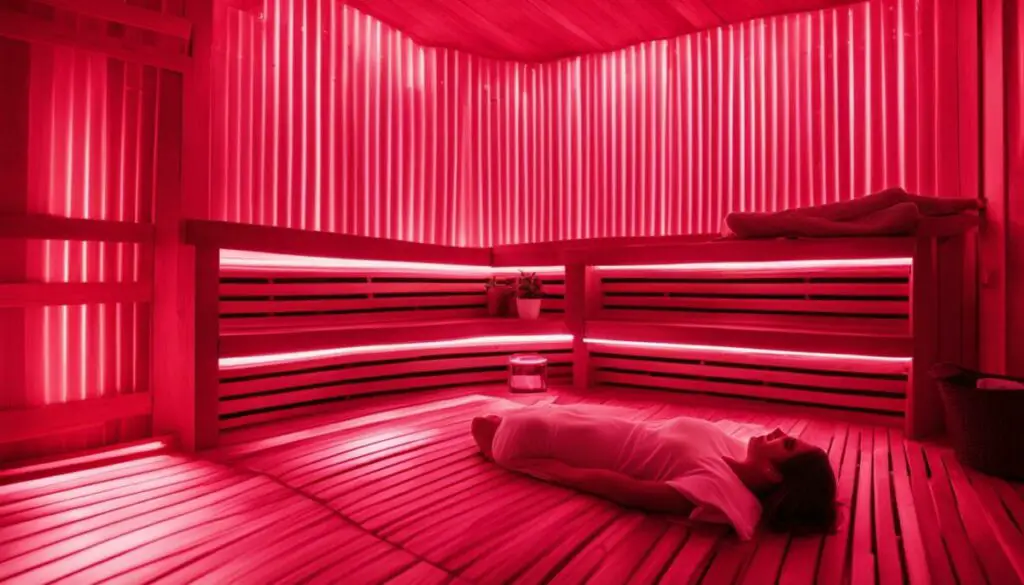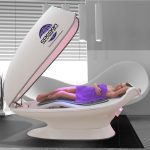Last Updated on 6 months by Francis
As alternative wellness treatments continue to gain popularity, you may have heard of infrared sauna therapy and red light therapy. But are they the same thing? Is infrared sauna red light therapy? In this section, we’ll explore the differences between the two and highlight the potential health benefits of this alternative wellness treatment.
Infrared sauna therapy involves sitting in a sauna that emits infrared light, which penetrates the skin and raises body temperature, inducing a deeper sweat than traditional saunas. On the other hand, red light therapy involves the use of low-level wavelengths of red or near-infrared light to promote healing, rejuvenation, and relaxation.
While these two therapies use different mechanisms, they may be combined to provide a more holistic approach to wellness. Infrared sauna red light therapy combines the heat and detoxifying benefits of infrared sauna therapy with the skin rejuvenating and stress-reducing benefits of red light therapy.
So, is infrared sauna red light therapy? While they are not the same thing, the integration of the two therapies can provide a unique and effective approach to alternative wellness. Let’s explore the potential health benefits of this treatment.
Contents
Key Takeaways
- Infrared sauna therapy and red light therapy are not the same thing, but they can be combined for a holistic approach to wellness.
- Infrared sauna therapy uses infrared light to induce a deeper sweat, while red light therapy uses low-level wavelengths to promote healing and relaxation.
- Infrared sauna red light therapy offers a combination of detoxifying and rejuvenating benefits for optimal health and wellness.
Understanding Infrared Sauna Therapy

When it comes to alternative wellness treatments, infrared sauna therapy is gaining popularity due to its numerous health benefits. This therapy involves the use of infrared heaters to emit infrared light, which penetrates the skin and heats the body from the inside out.
The temperature inside an infrared sauna typically ranges from 120 to 140 degrees Fahrenheit, which is lower than traditional saunas that use hot rocks or steam. This lower temperature makes it more tolerable to stay inside for longer periods, allowing for extended periods of relaxation and detoxification.
Health Benefits
One of the primary benefits of infrared sauna therapy is relaxation. The heat from the sauna helps to relax muscles and relieve tension, helping to reduce stress levels.
Infrared sauna therapy is also known for its ability to promote detoxification. Sweating in an infrared sauna helps to flush out toxins from the body, including heavy metals, chemicals, and pollutants.
Furthermore, infrared sauna therapy can provide pain relief for those suffering from arthritis, muscle soreness, or chronic pain conditions. The heat penetrates deep into the muscles, promoting circulation and providing relief from inflammation and pain.
Improved circulation is another health benefit associated with infrared sauna therapy. The heat causes blood vessels to dilate, increasing blood flow and oxygenation to the body’s tissues and organs.
Finally, infrared sauna therapy is known for its skin rejuvenation properties. The heat stimulates collagen production, reducing the appearance of fine lines and wrinkles, and improving the overall tone and texture of the skin.
Overall, infrared sauna therapy is a safe and effective way to promote wellness and improve overall health. Whether you’re looking to relax, detoxify, relieve pain, improve circulation, or rejuvenate your skin, infrared sauna therapy may be an excellent addition to your overall wellness routine.
Exploring Red Light Therapy

Red light therapy, also known as photobiomodulation, is an alternative wellness treatment that uses red and near-infrared light to stimulate cellular regeneration and repair.
This therapy has been around for decades but has gained popularity in recent years due to its wide range of healing properties.
One of the primary uses of red light therapy is for skin rejuvenation. The red and near-infrared wavelengths of light penetrate the skin, stimulating the production of collagen and promoting cellular repair, resulting in a more youthful and radiant-looking complexion.
Aside from its cosmetic benefits, red light therapy also has stress-reducing properties. It has been shown to lower cortisol levels in the body, which is the hormone associated with stress, making it a popular choice for those looking to improve their mental health and well-being.
Red light therapy is also known for its healing properties, with studies showing that it can aid in muscle recovery, reduce pain and inflammation, and even improve joint health in those with arthritis.
One of the most significant advantages of red light therapy is that it is non-invasive and does not involve any downtime, making it a safe and convenient option for those looking to improve their overall health and well-being.
Key Differences Between Infrared Sauna and Red Light Therapy

While both infrared sauna therapy and red light therapy are alternative wellness treatments, the key differences between them lie in their mechanisms and wavelengths of light used.
Infrared sauna therapy utilizes heat to warm the body and increase perspiration, resulting in detoxification, improved circulation, and pain relief. The heat penetrates deep into the tissues, promoting relaxation and aiding in muscle recovery.
On the other hand, red light therapy uses low-level wavelengths of red or near-infrared light to penetrate the skin, stimulating the production of collagen and cellular repair. This therapy has been shown to have skin rejuvenation and stress-reducing benefits, as well as aiding in wound healing and reducing inflammation.
In summary, infrared sauna therapy primarily focuses on heat and deep tissue penetration, while red light therapy focuses on skin rejuvenation and cellular repair.
| Infrared Sauna Therapy | Red Light Therapy |
|---|---|
| Uses heat to warm the body and promote detoxification, improved circulation, pain relief, and muscle recovery. | Uses low-level wavelengths of red or near-infrared light to stimulate collagen production and cellular repair, aiding in skin rejuvenation, wound healing, and inflammation reduction. |
| Primarily focuses on deep tissue penetration and relaxation. | Primarily focuses on cellular repair and skin rejuvenation. |
Ultimately, the choice between infrared sauna therapy and red light therapy depends on individual needs and preferences. While there is some overlap in the benefits of these therapies, understanding their unique mechanisms and wavelengths can help inform your decision.
Benefits of Infrared Sauna Red Light Therapy

Combining the healing properties of infrared sauna therapy with the skin rejuvenation and stress-reducing benefits of red light therapy can result in a powerful wellness treatment with numerous health benefits.
Health benefits: Studies have shown that infrared sauna red light therapy can help with pain relief, improved circulation, and skin rejuvenation, as well as stress reduction and detoxification.
Healing properties: Infrared saunas emit infrared radiation, which penetrates deep into the body’s tissues, promoting relaxation, reducing muscle tension, and improving overall well-being. The red light used in red light therapy stimulates the production of collagen in the skin, reducing the appearance of fine lines and wrinkles and promoting a brighter, more youthful complexion.
| Benefit | Description |
|---|---|
| Pain relief | The heat generated by the infrared sauna can help to reduce pain and inflammation in the body, making it an effective treatment for chronic pain conditions such as arthritis. |
| Improved circulation | The heat from the infrared sauna causes blood vessels to dilate, improving blood flow and oxygenation throughout the body. |
| Skin rejuvenation | The red light used in red light therapy stimulates the production of collagen in the skin, reducing the appearance of fine lines and wrinkles and promoting a brighter, more youthful complexion. |
| Stress reduction | The combination of heat and light therapy can help to reduce stress levels and promote relaxation, aiding in overall well-being. |
It’s important to note that the benefits of infrared sauna red light therapy may vary from person to person, and it’s essential to consult with a healthcare professional before starting any new wellness treatment.
Scientific Evidence Supporting Infrared Sauna Red Light Therapy

While the use of infrared sauna red light therapy is relatively new, there is growing scientific evidence to support its effectiveness in promoting health and wellness. Studies have shown that this alternative treatment can have a positive impact on a range of health concerns, including pain relief, improved circulation, and skin rejuvenation.
One study published in the journal Medical Science Monitor found that infrared sauna therapy can significantly reduce pain levels in patients with chronic pain conditions, such as fibromyalgia. The therapy was also shown to improve sleep quality and reduce fatigue in these patients.
Another study published in the American Journal of Medicine found that infrared sauna therapy can improve blood vessel function and increase circulation, which may contribute to cardiovascular health benefits.
Red light therapy has also been the subject of numerous scientific studies. One study published in the Journal of Cosmetic and Laser Therapy found that red light therapy can improve skin complexion and reduce the appearance of fine lines and wrinkles.
A review of multiple studies on red light therapy in the journal Clinical Interventions in Aging concluded that it has potential therapeutic effects on a variety of conditions, including musculoskeletal disorders, wound healing, and mental health concerns such as depression and anxiety.
Overall, the scientific evidence supporting the use of infrared sauna red light therapy is promising, with numerous studies demonstrating its potential health benefits. However, it’s important to note that more research is needed to fully understand the mechanisms of action and to determine the optimal treatment protocols.
Incorporating Infrared Sauna Red Light Therapy into Your Wellness Routine
Adding infrared sauna red light therapy to your wellness routine can be a transformative experience. Here are some tips to ensure you get the most out of your sessions:
Frequency and Duration of Sessions
The frequency and duration of your infrared sauna red light therapy sessions will depend on your individual needs and goals. It’s generally recommended to start with 15 to 20-minute sessions, two to three times per week, gradually increasing the duration and frequency over time. It’s important to listen to your body and adjust accordingly.
Safety Precautions
While infrared sauna red light therapy is generally considered safe for most people, there are some precautions you should take. Avoid using it if you are pregnant, have low blood pressure, or have a history of heart disease or stroke. Always consult with your doctor before beginning any new wellness regimen.
Potential Considerations
During your infrared sauna red light therapy session, wear loose, comfortable clothing and avoid wearing any jewelry or accessories that may interfere with the therapy. It’s also recommended to drink plenty of water before and after your session to stay hydrated.
Incorporating infrared sauna red light therapy into your regular wellness routine can have numerous health benefits such as improved circulation, pain relief, and stress reduction. If you’re interested in trying this therapy, consult with a healthcare professional to determine if it’s right for you.
Potential Side Effects and Precautions

While infrared sauna red light therapy is generally safe and well-tolerated, there are some potential side effects and precautions to consider before undergoing this treatment.
Side effects may include dizziness, nausea, dehydration, and overheating, especially if you stay in the sauna for too long or if you have underlying health conditions. It’s essential to start with shorter sessions and gradually increase the duration as you acclimate to the therapy. Remember to drink plenty of water before, during, and after your session to stay hydrated.
If you have a pre-existing medical condition, such as high blood pressure, heart disease, or diabetes, consult with your healthcare provider before using an infrared sauna. Pregnant women, children, and individuals on medication should also check with their doctors before starting infrared sauna red light therapy.
It’s crucial to follow safety guidelines when using an infrared sauna. Always use a timer, keep the sauna’s temperature within the recommended range, and avoid alcohol and other substances that can impair your judgment or increase your body temperature.
“I started using infrared sauna red light therapy to manage my chronic pain, but I didn’t realize the importance of staying hydrated during my sessions. I experienced dizziness and nausea, which made me concerned. After speaking with my healthcare provider and drinking more water during my sessions, I’ve had a much better experience and noticed a significant decrease in my pain.”
Exploring Other Alternative Wellness Treatments

While infrared sauna red light therapy offers a wide range of health benefits, it’s just one among many alternative wellness treatments available. By incorporating other treatments into your routine, you can optimize your overall physical and emotional well-being. Here are some alternative wellness treatments you may want to consider:
Aromatherapy
Aromatherapy uses essential oils from plants to improve physical and emotional health. Essential oils are typically inhaled or applied topically and can help reduce stress, improve sleep quality, ease pain, and boost immunity. According to a study conducted by the Department of Pharmaceutical Chemistry at KLE University’s College of Pharmacy, India, aromatherapy can positively impact psychological and physiological states.
Meditation
Meditation is a practice that involves training the mind to achieve a state of relaxation and mental clarity. By focusing on the present moment, meditation can help reduce stress, improve sleep quality, increase focus, and promote emotional well-being. According to a study published in the Journal of Medical Internet Research, meditation can help reduce symptoms of anxiety and depression, enhance cognitive function, and decrease stress.
Acupuncture
Acupuncture is a traditional Chinese medicine practice that involves inserting thin needles into specific points on the body to stimulate energy flow. Acupuncture can help reduce pain, improve digestion, boost immunity, and promote emotional well-being. According to a study published in the Journal of Alternative and Complementary Medicine, acupuncture can help reduce the frequency and severity of migraines and tension headaches.
Table:
If you’re interested in exploring other alternative wellness treatments, you may find the table below helpful. It provides an overview of some of the most popular alternative wellness treatments and the potential benefits they offer:
| Treatment | Potential benefits |
|---|---|
| Massage | Pain relief, stress reduction, improved circulation, enhanced flexibility |
| Yoga | Improved flexibility, increased strength, stress reduction, better sleep, enhanced focus |
| Chiropractic | Pain relief, improved posture, enhanced mobility, stress reduction |
No matter which alternative wellness treatments you choose, it’s important to consult with a healthcare professional to ensure safety and effectiveness. By incorporating a variety of treatments into your wellness routine, you can optimize your physical and emotional well-being for optimal overall health.
Testimonials and Success Stories
Don’t just take our word for it – hear from individuals who have experienced the benefits of infrared sauna red light therapy firsthand. These testimonials and success stories showcase the incredible impact this alternative wellness treatment can have on your overall health and well-being.
“I suffer from chronic pain due to an injury, and traditional treatments haven’t provided much relief. After trying infrared sauna red light therapy, I couldn’t believe the difference it made. My pain levels decreased significantly, and I felt more relaxed and rejuvenated than I have in years.”
— Michael S.
“As someone who suffers from acne, I’ve tried every topical treatment out there with minimal results. After incorporating infrared sauna red light therapy into my skincare routine, I noticed a significant improvement in my complexion. My skin was smoother, clearer, and more radiant than ever before.”
— Sarah J.
These are just a few examples of the many success stories we’ve heard from individuals who have tried infrared sauna red light therapy. If you’re curious about the benefits it can offer you, we encourage you to give it a try and see the incredible results for yourself.
Conclusion
After exploring the benefits and differences between infrared sauna therapy and red light therapy, it’s clear that incorporating infrared sauna red light therapy into your wellness routine can provide numerous benefits for your health and well-being.
It’s important to consult with a healthcare professional before starting any new therapy, especially if you have any underlying health conditions or concerns.
Final Thoughts
Infrared sauna red light therapy has been shown to promote relaxation, aid in detoxification, provide pain relief, improve circulation, rejuvenate the skin, and reduce stress levels.
By considering the potential benefits of this therapy for your overall wellness, and incorporating it into your routine with guidance from a professional, you can achieve optimal health and well-being.
Thank you for taking the time to explore this alternative wellness treatment with us. We hope this information has been helpful in your journey towards a healthier you.
FAQ
What is infrared sauna red light therapy?
Infrared sauna red light therapy is a combination of infrared sauna therapy and red light therapy. It involves the use of infrared heat and red light wavelengths to provide various health benefits.
How does infrared sauna red light therapy work?
Infrared sauna red light therapy works by emitting infrared heat and red light wavelengths that penetrate the body’s tissues. This process helps to improve circulation, stimulate collagen production, reduce pain, and promote overall well-being.
What are the health benefits of infrared sauna red light therapy?
Infrared sauna red light therapy offers numerous health benefits, including improved circulation, pain relief, relaxation, detoxification, enhanced skin rejuvenation, and stress reduction.
How often should I undergo infrared sauna red light therapy?
The frequency of infrared sauna red light therapy sessions can vary depending on individual needs and goals. It is generally recommended to start with 2-3 sessions per week and then adjust as necessary based on your body’s response.
Is infrared sauna red light therapy safe?
Yes, infrared sauna red light therapy is generally considered safe. However, it is important to follow safety precautions, such as staying hydrated, avoiding excessive exposure, and consulting with a healthcare professional before starting any new therapy.
Can anyone undergo infrared sauna red light therapy?
While infrared sauna red light therapy is generally safe for most individuals, it is important to consult with a healthcare professional if you have any underlying health conditions or concerns. They can provide personalized guidance based on your specific needs.
Are there any potential side effects of infrared sauna red light therapy?
Infrared sauna red light therapy is considered low-risk, but some individuals may experience temporary side effects such as mild dizziness, fatigue, or skin irritation. These side effects are typically mild and subside shortly after the session.
Can I combine infrared sauna red light therapy with other wellness treatments?
Yes, infrared sauna red light therapy can be combined with other alternative wellness treatments such as acupuncture, aromatherapy, and meditation. These modalities can complement each other and enhance your overall well-being.
Where can I find more information about infrared sauna red light therapy?
For more information about infrared sauna red light therapy, it is recommended to consult with a healthcare professional or wellness practitioner who specializes in this treatment. They can provide personalized guidance and address any specific questions or concerns you may have.









